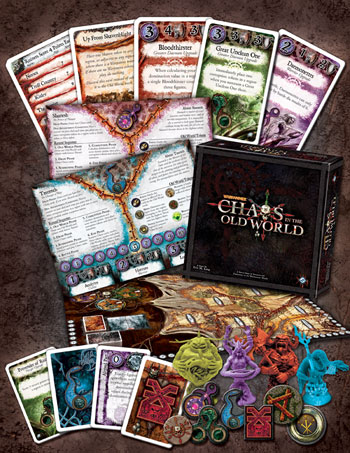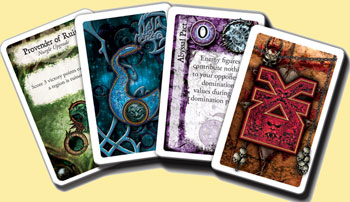GTM #116 - Chaos in the Old World Board Game
Sep 25, 2009
 In Chaos in the Old World, players take on the roles of Khorne, Nurgle, Tzeentch, and Slaanesh: four gods of evil, vying for domination over the Old World. Warhammer fans will know to expect a game full of battles and conflict; but the gods' goals are subtle, and simply throwing armies at the enemies will not bring victory. This reviewer was not familiar with the Warhammer universe; however, I found the theme evocative and, through both the art and rules, quickly came to understand and enjoy the flavor of the factions.
In Chaos in the Old World, players take on the roles of Khorne, Nurgle, Tzeentch, and Slaanesh: four gods of evil, vying for domination over the Old World. Warhammer fans will know to expect a game full of battles and conflict; but the gods' goals are subtle, and simply throwing armies at the enemies will not bring victory. This reviewer was not familiar with the Warhammer universe; however, I found the theme evocative and, through both the art and rules, quickly came to understand and enjoy the flavor of the factions.
The art, as we have come to expect from Fantasy Flight, is lavish and attractive; the board full of useful information, understated so as to showcase the dark theme. Note that Chaos in the Old World is not a game for children or squeamish adults. The game board itself appears to be a map carved into skin; the characters delight in pain and murder. The figures are attractive, with a different model for the higher-level demons of each faction: appropriate, because each has unique powers.
The gods vie for domination in two ways. First, every god has a dial that advances when a goal is met; the goal is specific to each god. For instance, Khorne, a god of battle, advances his dial by destroying rivals in battle, whereas Nurgle, a god of disease, advances by corrupting heavily populated areas. Each step of the dial gives some benefit (upgraded units, the chance to affect the board, and so on); the final step is victory.
 The second means for domination is control of the regions of the Old World. Each of the nine provinces has a resistance value representing the strength of the native opposition; if a god can overcome this value with units and special Chaos Cards, the region will yield victory points every turn. Even further, victory points can be won by corrupting a region so much that it is ruined forever; an immediate bonanza, but with no further earnings in the future. If one god reaches 50 VPs before any god reaches the end of the dial, that god wins; Nurgle, with many dial steps and easy corruption, tends to favor this victory condition. VPs are also used to break ties in the (quite likely) event that several gods finish their dials on the same turn.
The second means for domination is control of the regions of the Old World. Each of the nine provinces has a resistance value representing the strength of the native opposition; if a god can overcome this value with units and special Chaos Cards, the region will yield victory points every turn. Even further, victory points can be won by corrupting a region so much that it is ruined forever; an immediate bonanza, but with no further earnings in the future. If one god reaches 50 VPs before any god reaches the end of the dial, that god wins; Nurgle, with many dial steps and easy corruption, tends to favor this victory condition. VPs are also used to break ties in the (quite likely) event that several gods finish their dials on the same turn.
The most notable feature about Chaos in the Old World is the asymmetry between the factions. Each has a different dial advancement goal, different rewards on the dial, and different dial lengths. For instance, Slaanesh has a relatively difficult condition, but needs few dial steps to win. Nurgle has an easy condition that will also help him advance his points, but his dial needs so many steps that he will probably only be able to win with points. Each god has followers with different strengths, different Chaos Cards (spells played to a province that can change the battlefield), and different upgrades offered as they advance their dials. To give some idea of the different gods:
- Khorne has powerful followers that do a lot of damage, and gains dial advancements by using them to kill enemies.
- Nurgle has many inexpensive but weak followers; he uses them to overwhelm regions and gain dominance.
- Tzeentch has relatively weak followers, but has access to more and cheaper Chaos Cards than the other gods, so he can interfere with plans as he sees fit.
- Slaanesh has durable followers that can live through battle to corrupt again, and cards that can help him properly spread and take advantage of the corruption.

|
At the beginning of each turn, an event is drawn from the Old World deck; some of these events affect specific regions (the hapless "good guys" desperately fighting back), others affect the entire board, and still others are controlled by the player in last place (according to the dial). The meat of the turn is the Summoning Phase: in turn, each player spends power points to add or move followers to the board, or play Chaos Cards. After all summoning is finished, a battle occurs in every contested region; then the survivors get to spread corruption and gain VP for dominance. Victory is checked at the end of the round; a player with a finished dial has priority to win; next, a player with 50 VPs; or if five regions have been ruined, the player with the most VPs wins. In the unlikely event that the Old World deck is exhausted before any player wins, the forces of chaos are repelled and all players lose.
Clocking at a solid 90 minutes for 3 or 4 players, Chaos in the Old World is a rewarding pseudo-wargame that requires each player to learn their Chaos Power’s unique play style quickly if they want a chance at victory.


